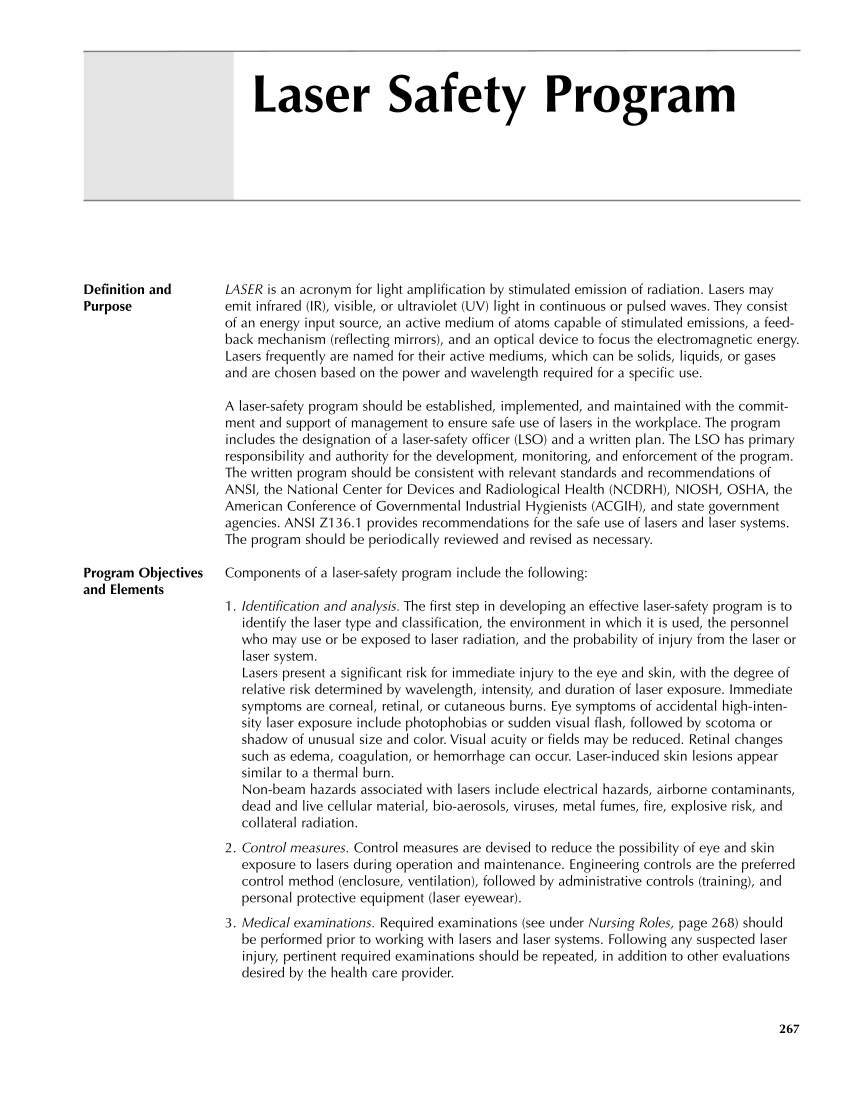LASER is an acronym for light amplification by stimulated emission of radiation. Lasers may emit infrared (IR), visible, or ultraviolet (UV) light in continuous or pulsed waves. They consist of an energy input source, an active medium of atoms capable of stimulated emissions, a feed- back mechanism (reflecting mirrors), and an optical device to focus the electromagnetic energy. Lasers frequently are named for their active mediums, which can be solids, liquids, or gases and are chosen based on the power and wavelength required for a specific use. A laser-safety program should be established, implemented, and maintained with the commit- ment and support of management to ensure safe use of lasers in the workplace. The program includes the designation of a laser-safety officer (LSO) and a written plan. The LSO has primary responsibility and authority for the development, monitoring, and enforcement of the program. The written program should be consistent with relevant standards and recommendations of ANSI, the National Center for Devices and Radiological Health (NCDRH), NIOSH, OSHA, the American Conference of Governmental Industrial Hygienists (ACGIH), and state government agencies. ANSI Z136.1 provides recommendations for the safe use of lasers and laser systems. The program should be periodically reviewed and revised as necessary. Components of a laser-safety program include the following: 1. Identification and analysis. The first step in developing an effective laser-safety program is to identify the laser type and classification, the environment in which it is used, the personnel who may use or be exposed to laser radiation, and the probability of injury from the laser or laser system. Lasers present a significant risk for immediate injury to the eye and skin, with the degree of relative risk determined by wavelength, intensity, and duration of laser exposure. Immediate symptoms are corneal, retinal, or cutaneous burns. Eye symptoms of accidental high-inten- sity laser exposure include photophobias or sudden visual flash, followed by scotoma or shadow of unusual size and color. Visual acuity or fields may be reduced. Retinal changes such as edema, coagulation, or hemorrhage can occur. Laser-induced skin lesions appear similar to a thermal burn. Non-beam hazards associated with lasers include electrical hazards, airborne contaminants, dead and live cellular material, bio-aerosols, viruses, metal fumes, fire, explosive risk, and collateral radiation. 2. Control measures. Control measures are devised to reduce the possibility of eye and skin exposure to lasers during operation and maintenance. Engineering controls are the preferred control method (enclosure, ventilation), followed by administrative controls (training), and personal protective equipment (laser eyewear). 3. Medical examinations. Required examinations (see under Nursing Roles, page 268) should be performed prior to working with lasers and laser systems. Following any suspected laser injury, pertinent required examinations should be repeated, in addition to other evaluations desired by the health care provider. 267 Definition and Purpose Program Objectives and Elements Laser Safety Program
Purchased from OEM Press by (ge corporate access). (C) 2013 OEM Health Information, Inc. All rights reserved.












































































































































































































































































































































































































































